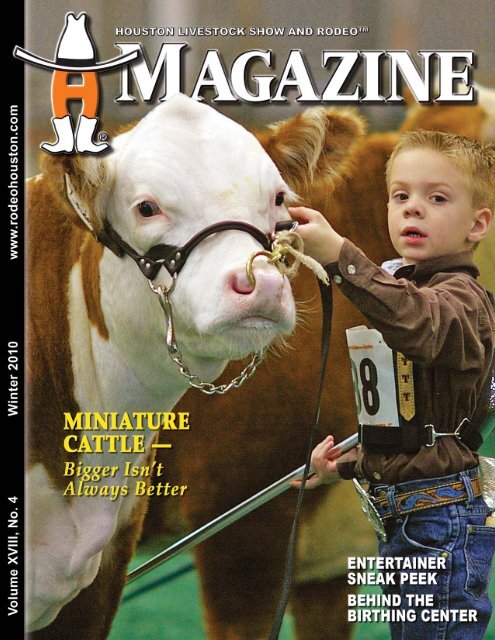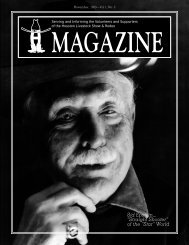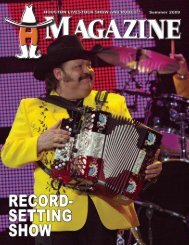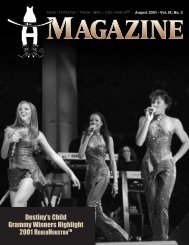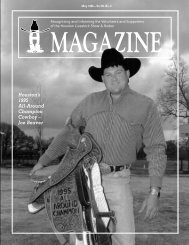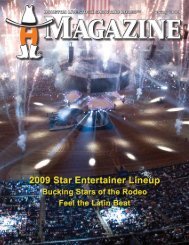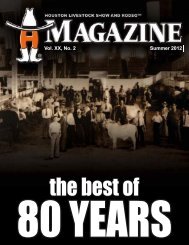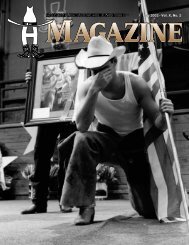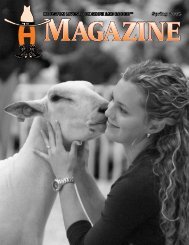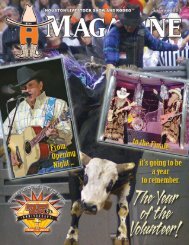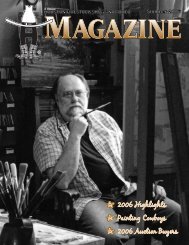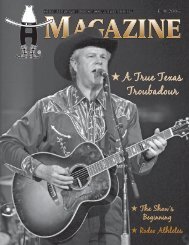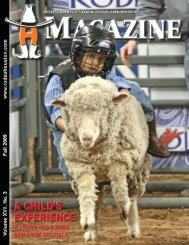trailblazer - Houston Livestock Show and Rodeo
trailblazer - Houston Livestock Show and Rodeo
trailblazer - Houston Livestock Show and Rodeo
Create successful ePaper yourself
Turn your PDF publications into a flip-book with our unique Google optimized e-Paper software.
Committee Spotlights<br />
<strong>Livestock</strong> ... 19<br />
Trailblazer ... 19<br />
Trailride ... 20<br />
<strong>Rodeo</strong> Roundup ... 21<br />
Silly Boys – Ag Mechanics Is<br />
for Girls ... 2<br />
All-girl teams give the Agricultural<br />
Mechanics Project <strong>Show</strong> a woman’s touch.<br />
B<strong>and</strong>ing, Not Br<strong>and</strong>ing ... 5<br />
Volunteers prepare chicks for Junior<br />
Market Broiler <strong>Show</strong> exhibitors.<br />
Deep Fried Dreams ... 7<br />
From deep-fried cupcakes to funnel cakes,<br />
the <strong>Show</strong> offers a plethora of deep-fried<br />
delicacies to make the mouth water!<br />
Entertainer Sneak Peak ... 8<br />
Check out which entertainers have been<br />
Economic<br />
announced for 2011 RODEOHOUSTON!<br />
Impact ... 10<br />
The <strong>Show</strong> provides economic<br />
stimulus to <strong>Houston</strong> area.<br />
RODEOHOUSTON<br />
R<br />
Super Shootout ... 11<br />
Top 10 North American<br />
champions in select events<br />
compete for $200,000 total<br />
purse <strong>and</strong> bragging rights.<br />
Behind the Birthing Center ... 12<br />
Streaming live births provides teachable moments<br />
at Capital One Bank AGVENTURE Birthing Center.<br />
Cultivating Culture:<br />
Alley Theatre ... 14<br />
Programs provide students of all<br />
ages an opportunity to experience<br />
the joys of drama <strong>and</strong> theatre.<br />
Miniature Cattle —<br />
Bigger Isn’t<br />
Always Better ... 16<br />
The efficiency <strong>and</strong> size of mini<br />
cattle catch the attention of<br />
the dairy <strong>and</strong> beef industry.<br />
The Cover<br />
Although small<br />
in size, miniature<br />
cattle catch the<br />
eyes of <strong>Show</strong><br />
visitors.<br />
MAGAZINE COMMITTEE<br />
OFFICER IN CHARGE<br />
Pam Springer<br />
CHAIRMAN<br />
Gina Steere<br />
VICE CHAIRMEN<br />
Copy Editor<br />
Samantha Fewox<br />
Assignments Editor<br />
Ken Scott<br />
EDITORIAL BOARD<br />
Katie Lyons<br />
Melissa Manning<br />
Kenneth C. Moursund Jr.<br />
Tracy L. Ruffeno<br />
Marshall R. Smith III<br />
Kristi Van Aken<br />
Todd Zucker<br />
PHOTOGRAPHERS<br />
Lisa Norwood<br />
Debbie Porter<br />
Lisa Van Etta<br />
REPORTERS<br />
Sonya Aston<br />
Stephanie Earthman Baird<br />
Allyson B<strong>and</strong>y<br />
Scott Bumgardner<br />
Br<strong>and</strong>y Divin<br />
Denise Doyle<br />
Todd Eudy<br />
Kate Gunn<br />
Terrie James<br />
Sarah Langlois<br />
Brad Levy<br />
Lawrence S Levy<br />
Becky Lowicki<br />
Elizabeth Martin<br />
Gigi Mayorga-Wark<br />
Nan McCreary<br />
Crystal McKeon<br />
Rochelle McNutt<br />
Laura S<strong>and</strong>ers<br />
S<strong>and</strong>ra Hollingsworth Smith<br />
Jodi Sohl<br />
Emily Wilkinson<br />
HOUSTON LIVESTOCK SHOW<br />
AND RODEO<br />
MAGAZINE COORDINATION<br />
MARKETING & PUBLIC RELATIONS<br />
DIVISION<br />
MANAGING DIRECTOR,<br />
COMMUNICATIONS<br />
Clint Saunders<br />
COORDINATOR, COMMUNICATIONS<br />
Lauren Rouse<br />
DESIGN / LAYOUT<br />
Amy Noorian<br />
STAFF PHOTOGRAPHERS<br />
Francis M. Martin, D.V. M.<br />
Dave Clements<br />
Winter, Volume XVIII, No. 4,<br />
is published quarterly by the<br />
<strong>Houston</strong> <strong>Livestock</strong> <strong>Show</strong> <strong>and</strong> <strong>Rodeo</strong>.<br />
Copyright © 2010<br />
Letters <strong>and</strong> comments should be sent to:<br />
Marketing & Public Relations Division<br />
<strong>Houston</strong> <strong>Livestock</strong> <strong>Show</strong> <strong>and</strong> <strong>Rodeo</strong><br />
P. O. Box 20070<br />
<strong>Houston</strong>, Texas 77225-0070<br />
832.667.1000<br />
www.rodeohouston.com • www.hlsr.com
SHOW OFFICIALS<br />
CHAIRMAN OF THE BOARD<br />
Charles R. “Butch” Robinson<br />
PRESIDENT / C.E.O.<br />
Skip Wagner<br />
CHIEF OPERATING OFFICER<br />
Leroy Shafer<br />
VICE PRESIDENTS<br />
David Boothe<br />
Curtis Brenner<br />
George A. Buschardt<br />
Tom Davis<br />
Warner D. Ervin<br />
Rey Gonzales<br />
Paul F. Lehnhoff<br />
E.D. Lester<br />
Tom Lippincott<br />
Ken McGuyer<br />
Michael S. “Mike” McKinney<br />
Yance S. Montalbano<br />
Tim Ping<br />
Steve Roe<br />
Darryl Schroeder<br />
Pam Springer<br />
Jim VanHoozer<br />
Pat Walker<br />
GENERAL MANAGER<br />
Joe Bruce Hancock<br />
EXECUTIVE COMMITTEE<br />
Jim Bloodworth<br />
Tilman J. Fertitta<br />
Wayne Hollis<br />
Don D. Jordan<br />
Stuart Lang<br />
Jack A. Lyons<br />
Ed McMahon<br />
Louis M. Pearce Jr.<br />
Charles R. “Butch” Robinson<br />
John O. Smith<br />
Paul G. Somerville<br />
Keith A. Steffek<br />
R.H. “Steve” Stevens<br />
P. Michael Wells<br />
LIFETIME MEMBERS OF THE<br />
EXECUTIVE COMMITTEE<br />
Don A. Buckalew<br />
John Causey<br />
J.M. “Jim” Clepper<br />
John T. Cook<br />
James M. Windham<br />
AGRICULTURE<br />
★<br />
EDUCATION<br />
★<br />
ENTERTAINMENT<br />
★<br />
WESTERN<br />
HERITAGE<br />
While the outside temperature may be cooling down, things are<br />
heating up in Reliant Center with committee meetings in full swing<br />
as our staff <strong>and</strong> volunteers get ready for the 2011 <strong>Houston</strong> <strong>Livestock</strong><br />
<strong>Show</strong> <strong>and</strong> <strong>Rodeo</strong>! And what a great <strong>Show</strong> it promises to be.<br />
Inside this issue you will find a preview of the 2011<br />
RODEOHOUSTON entertainer lineup <strong>and</strong> our Season <strong>and</strong> Mini-<br />
Season Ticket information. We are off to a great start with these<br />
entertainers, so watch for more entertainer <strong>and</strong> <strong>Show</strong> information<br />
as it becomes available.<br />
The <strong>Show</strong> recently received the results of an economic impact<br />
study conducted by Barton A. Smith, Ph.D., a University of<br />
<strong>Houston</strong> economics professor, <strong>and</strong> I am eager to share<br />
some exciting findings with you. This study<br />
indicates how strongly the <strong>Show</strong> impacts not<br />
only our local economy, but also that of the<br />
state <strong>and</strong> the nation.<br />
The study found that, because of the<br />
<strong>Show</strong>, gross sales in the region increase<br />
by nearly half a billion dollars! In<br />
addition, regional incomes are raised<br />
by more than $290 million, <strong>and</strong> more<br />
than 7,200 full-time equivalent jobs are<br />
generated. We also are pleased to report<br />
that a fiscal dividend of more than<br />
$27 million goes to local governments.<br />
These numbers are significant because<br />
our <strong>Show</strong> brings outside dollars into the<br />
region that are spent locally throughout<br />
various sectors of the economy,<br />
including hotel accommodations <strong>and</strong><br />
other off-grounds expenditures. This<br />
represents a major annual boost to<br />
the economy in which each of you, as<br />
a volunteer, plays a major role. It is<br />
indeed something to be proud of.<br />
With the holiday season upon us, I<br />
would like to wish you <strong>and</strong> your family<br />
the very best. The new year will be here<br />
soon with the 2011 <strong>Show</strong> right around the<br />
corner. Let’s make it a good one!<br />
Happy Holidays!<br />
Butch Robinson<br />
1
2<br />
By Sonya Aston
Watch out, boys! The girls have discovered the secret that agricultural<br />
mechanics is a lot of fun, builds character <strong>and</strong> could use a woman’s touch.<br />
Up <strong>and</strong> down the aisles of the Agricultural Mechanics Project<br />
<strong>Show</strong>, the color pink slyly embellishes macho projects, <strong>and</strong><br />
every once in a while, pink hits you right between the eyes.<br />
Girls have joined agricultural mechanics classes for a variety<br />
of reasons: creating female-friendly equipment, producing<br />
something useful <strong>and</strong> important, or just for the satisfaction of<br />
completing a big project.<br />
Savannah Williams had experience in leather projects <strong>and</strong><br />
decided to take on the ultimate leather project — a saddle.<br />
The ornate tooling is a Texas basket-weave stamp with a<br />
half flower as a border. “This saddle is not as heavy <strong>and</strong>,<br />
therefore, easier to carry for a woman,” Savannah said.<br />
Brittini Bailey <strong>and</strong> Allie Vasquez, who have been in<br />
agricultural mechanics classes for three years, worked<br />
well together <strong>and</strong> decided to do a project as a team. They<br />
designed a black gate showing thundering horses with<br />
flying manes. Brittini said, “This gate is special because the<br />
metal is a flat bar <strong>and</strong> each piece is bent by h<strong>and</strong>.” Proudly<br />
demonstrating the technique of bending the flat bar to form<br />
their beautiful creation, Brittini said, “We have already been<br />
offered $2,500 for the gate.”<br />
Taylor Mitchell’s father is an agricultural mechanics teacher<br />
<strong>and</strong> encouraged his daughter <strong>and</strong> her friends to have an<br />
all-girl team. Four girls from Kerens, Texas, wanted to build<br />
something that benefited their school, so the team built a<br />
black shop table accented by bright pink flecks. The table is<br />
5 feet by 10 feet <strong>and</strong> is outfitted with a crane <strong>and</strong> three vises,<br />
one being a pipe vise.<br />
While Courtney Wilcox demonstrated the importance of<br />
the placement of the support beams underneath the table,<br />
Taylor walked every passerby through the photo album<br />
documenting the history of their creation. It was intimidating<br />
3
to compete because usually you don’t see an all-girl team,”<br />
Courtney said. “It was an honor to do it. It improved our<br />
character, <strong>and</strong> we learned that we can do it just as good as<br />
the guys.”<br />
Chelsea Low <strong>and</strong> Krystal Yager get spectators to investigate<br />
the light bar attachment they created for a pickup truck.<br />
“This bar is useful for feeding cattle or doing anything that<br />
you need to do at nighttime,” Chelsea said. “Our ag teacher<br />
decided that it should be an all-girl team.”<br />
“We work well together, <strong>and</strong> we did our own wiring. My<br />
dad is a welder; he gave us some good advice,” Krystal said.<br />
Excited that the light bar will be used by the agricultural<br />
department of their school, both girls are proud of their<br />
invention.<br />
Thrilled about their all-girl team, Courtney Cole <strong>and</strong> Amber<br />
Rushing show off their photo album emblazoned with the<br />
words, “Silly Boys — Ag Mechanics Is for Girls.” This is their<br />
first Agricultural Mechanics Project <strong>Show</strong>. Describing the real<br />
motivation behind their project, Courtney said, “We really<br />
want to kick the boys’ butts.” The girls built a trailer that<br />
was painted with huge pink accents. “Our lights worked the<br />
first time, <strong>and</strong> we started after the boys <strong>and</strong> finished before<br />
them,” Amber said.<br />
Am<strong>and</strong>a Weaver <strong>and</strong> Ashley Waters have been garnering<br />
attention across the state with their pink wildlife observation<br />
booth/deer blind. The booth is flashy to the human eye with<br />
its pink <strong>and</strong> green camouflage design. “The animals will<br />
only see straight lines, so we made them crooked <strong>and</strong> they<br />
do not see the colors, so the pink is perfect,” Am<strong>and</strong>a said.<br />
This booth is decked out with carpet, lights <strong>and</strong> a magazine<br />
rack. The inspiration for this project came from their teacher,<br />
who is a breast cancer survivor. “We are going to sell the<br />
booth <strong>and</strong> donate the proceeds to fund research to help fight<br />
breast cancer,” Am<strong>and</strong>a said. When asked why they chose an<br />
all-girl group, Ashley said, “We wanted to learn to build it by<br />
ourselves, because boys always take over the project.”<br />
Whatever the motivation — charitable causes, experience or<br />
sheer competition — it is clear that girls are not only doing a<br />
great job in agricultural mechanics, but they are doing it with<br />
flair.<br />
4
By Lawrence S Levy<br />
What do you get when you combine thous<strong>and</strong>s<br />
of day-old chicks, Breeders Greeters Committee<br />
volunteers, <strong>and</strong> a couple of dozen Texas<br />
A&M Aggies, all gathered on the campus of Texas A&M<br />
University? It is the beginnings of the <strong>Houston</strong> <strong>Livestock</strong><br />
<strong>Show</strong> <strong>and</strong> <strong>Rodeo</strong> Junior Market Broiler competition.<br />
To secure a single source of broiler chicks for all participating<br />
Texas FFA <strong>and</strong> 4-H youth programs, a few logistical<br />
questions had to be answered, including how project chicks<br />
would be distributed efficiently <strong>and</strong> in a timely manner to<br />
the youth exhibitors.<br />
The <strong>Show</strong> orders 30,000 to 50,000 day-old chicks from a<br />
single breeder of broiler chicks based upon pre-orders<br />
received in January from FFA <strong>and</strong> 4-H advisers. Set for<br />
delivery to Texas A&M’s Pearce Animal Pavilion the first<br />
week of February, containers full of chicks are stacked<br />
around the arena <strong>and</strong> sounds of little chirps echo off the<br />
pavilion walls.<br />
With birds in h<strong>and</strong>, a process was needed to verify that<br />
a broiler entered in the <strong>Show</strong>’s Junior Market Broiler<br />
competition was from those hatched in February. A simple<br />
yet elegant process was devised. Each day-old chick would<br />
be identified with a small b<strong>and</strong> of metal embossed with a<br />
unique number.<br />
At 7:30 a.m. the day the chicks are delivered, more than<br />
100 Breeders Greeters Committee volunteers gear up with<br />
gloves, crimping tools <strong>and</strong> enthusiastic smiles. Gathering<br />
around a dozen tables, volunteers separate into groups of<br />
eight to 10. Experienced volunteers guide first-timers, as<br />
each chick is b<strong>and</strong>ed, counted <strong>and</strong> readied for distribution<br />
by 2 p.m.<br />
Every chick must be b<strong>and</strong>ed humanely, <strong>and</strong> the technique<br />
requires a delicate touch.<br />
Once the b<strong>and</strong> is in place, its number is recorded <strong>and</strong> the<br />
chick is passed to a crimper, who specializes in using a<br />
5
crimping tool to make the b<strong>and</strong> into a figure-eight. Fastened<br />
tightly onto itself, the b<strong>and</strong> will remain secure in the wing,<br />
yet able to rotate freely, with no harm to the chick as it grows.<br />
The tag number is verified, <strong>and</strong> the chick is put back into<br />
a container. As each container is filled with chicks, <strong>and</strong> the<br />
b<strong>and</strong> numbers have been recorded to that container, it is<br />
moved across the arena to the distribution point.<br />
Beginning as early as noon, FFA <strong>and</strong> 4-H advisers arrive to<br />
pick up the birds they ordered to take back to their students.<br />
After taking possession of a complete order, each adviser<br />
takes the time to inspect every container <strong>and</strong> every chick.<br />
The objective is to produce a winning pen of broilers in a<br />
month’s time.<br />
Angelina County adviser Steve Gardner arrived early to pick<br />
up seven boxes of chicks to take back to his county’s hopeful<br />
exhibitors.<br />
“I look to see that every bird has a b<strong>and</strong>. A kid can’t show a<br />
b<strong>and</strong>less chick. Coloration has to be consistent. And, I’ll cull<br />
on size. I pick up every bird in my h<strong>and</strong>. That way, I can see<br />
how active <strong>and</strong> strong it is,” he said.<br />
On this one day for advisers, all roads lead to College<br />
Station, Texas, but the stay is short. As soon as boxes of<br />
birds are received, inspected <strong>and</strong> signed off, all roads lead<br />
back home, where empty roosts wait to be filled <strong>and</strong> hopeful<br />
exhibitors dream of raising the Gr<strong>and</strong> Champion Pen of<br />
Broilers.<br />
6
By Brad Levy<br />
As any yearly attendee of the <strong>Houston</strong> <strong>Livestock</strong> <strong>Show</strong><br />
<strong>and</strong> <strong>Rodeo</strong> will attest, one of the best parts of the<br />
<strong>Show</strong> experience is the opportunity to partake in the<br />
plethora of tasty foods that are available. Personally, I have<br />
spent the last 20 years indulging in the best barbecue, smoked<br />
turkey legs <strong>and</strong> decadent sweets in Texas, but I had always<br />
overlooked the food booths that advertised the dreaded “F”<br />
word — “fried.” In 2010, I exp<strong>and</strong>ed my horizons!<br />
With more than 30 deep-fried foods available, I was poised to<br />
spend my time sampling different items each day. Who can<br />
resist deep-fried Twinkies®, cupcakes, cheesecakes, beignets<br />
<strong>and</strong> funnel cakes? One vendor offered a good selection with<br />
its fun <strong>and</strong> refreshing approach to fried foods with the help<br />
of two large deep-fry pressure cookers. The vendor is part<br />
of a brother team who takes pride in its distinctive array of<br />
fried foods. Weeks before the start of the <strong>Show</strong>, the brothers<br />
traveled to <strong>Houston</strong> to find local vendors to build their entire<br />
menu <strong>and</strong> were excited to share their food with the public.<br />
However, since this was my first year eating fried items, I<br />
narrowed it down to an old favorite <strong>and</strong> a couple of spins on<br />
some healthy treats.<br />
My first bite into the deep-fried s’mores brought back<br />
memories of camping out <strong>and</strong> building s’mores by the<br />
campfire. The sweet flavor of the marshmallow, chocolate<br />
<strong>and</strong> graham crackers — all deep-fried — was incredible! I<br />
must warn you, though, that this item may require a little<br />
cleanup; the chocolaty goodness can get a bit messy.<br />
As for the old-time hot dog, it has been given a new, healthy<br />
twist. The “zucchini weenie” is a beef hot dog stuffed into a<br />
shell of zucchini, coated with a sweet corn batter <strong>and</strong> deep<br />
fried. The end result is aesthetically pleasing <strong>and</strong> flavorful.<br />
Last, but not least, a favorite of Californians, <strong>and</strong> now a<br />
favorite of Texans, is the deep-fried avocado. I was skeptical<br />
that it would hold up during the frying process, but indeed it<br />
did. The fried portion accents the flavor <strong>and</strong> creamy avocado<br />
texture, while the dipping sauce complements it nicely.<br />
After all the dust settled at the 2010 <strong>Show</strong>, visitors had<br />
ordered more than 3,000 fried avocados <strong>and</strong> s’mores, making<br />
two of my favorite picks top sellers.<br />
These deep fried delicacies are just a few of the foods I will<br />
be dreaming about for the 2011 <strong>Houston</strong> <strong>Livestock</strong> <strong>Show</strong> <strong>and</strong><br />
<strong>Rodeo</strong>. I cannot wait to see what new concoctions will be<br />
offered. I cannot wait to eat these favorites <strong>and</strong> try some new<br />
tasty treats from from the winning food vendors of the 2011<br />
Gold Buckle Foodie Awards. My stomach is already making<br />
room.<br />
7
Season <strong>and</strong> Mini-Season tickets are now on sale with four exciting superstars as part of the lineup for 2011<br />
RODEOHOUSTON. The first four entertainers announced to perform on the 2011 RODEOHOUSTON stage are Sugarl<strong>and</strong>,<br />
Selena Gomez, Zac Brown B<strong>and</strong> <strong>and</strong> Brad Paisley.<br />
“All I can say is, buy your tickets now! This is just the beginning of an incredible 2011 <strong>Rodeo</strong> season,” said Skip Wagner,<br />
president of the <strong>Show</strong>. “With these stars, action-packed rodeo events, <strong>and</strong> more stars on the way, everyone in the family is<br />
going to have a great time.”<br />
SEASON TICKETS<br />
The only sure way to see these four performances, plus 16 more, is with <strong>Houston</strong> <strong>Livestock</strong> <strong>Show</strong> <strong>and</strong> <strong>Rodeo</strong> Season<br />
Tickets, which are on sale now. Season Tickets start as low as $336 a seat <strong>and</strong> there is currently a good supply.<br />
MINI-SEASON TICKETS<br />
Mini-Season Tickets, with nine great performances in each option, are available to purchase now. Mini-Season Ticket<br />
seating is located in the loge <strong>and</strong> upper levels of Reliant Stadium. Option A can be purchased for $154 in the Upper Level<br />
<strong>and</strong> $189 in the Loge Level, <strong>and</strong> Option B can be purchased for $146 in the Upper Level <strong>and</strong> $189 in the Loge Level.<br />
Option A Dates<br />
Option B Dates<br />
Tuesday, March 1<br />
Wednesday, March 2 *Value Day<br />
Thursday, March 3 – Sugarl<strong>and</strong> Saturday, March 5<br />
Monday, March 7<br />
Sunday, March 6 – Selena Gomez<br />
Tuesday, March 8<br />
Wednesday, March 9 *Value Day<br />
Thursday, March 10 Friday, March 11<br />
Monday, March 14 Saturday, March 12<br />
Wednesday, March 16 *Value Day Tuesday, March 15<br />
Friday, March 18<br />
Thursday, March 17 – Zac Brown B<strong>and</strong><br />
Saturday, March 19 – Brad Paisley Sunday, March 20<br />
*Upper level tickets on Value Day Wednesdays are only $10.<br />
Black Heritage Day, Friday, March 4, <strong>and</strong> Go Tejano Day, Sunday, March 13, are available as part<br />
of the Season Ticket line-up, but are not included in the Mini-Season Ticket options.<br />
HOW TO PURCHASE SEASON TICKETS AND MINI-SEASON TICKETS<br />
Season <strong>and</strong> Mini-Season tickets are on sale now <strong>and</strong> can be purchased by:<br />
• visiting www.rodeohouston.com<br />
• calling the <strong>Show</strong>’s Ticket Office at 832.667.1080<br />
• visiting the <strong>Show</strong>’s Ticket Windows on the second floor of Reliant Center, Monday through Friday, 8:30 a.m. to 4:30 p.m.<br />
8
From data collected from the 2010 <strong>Show</strong>, the <strong>Houston</strong><br />
<strong>Livestock</strong> <strong>Show</strong> <strong>and</strong> <strong>Rodeo</strong> is excited to release<br />
results of its economic impact study prepared by<br />
Barton Smith, Ph.D., Professor of Economics, Emeritus,<br />
University of <strong>Houston</strong>.<br />
“While the primary benefit of the <strong>Rodeo</strong> is the unparalleled<br />
entertainment opportunities it provides the region <strong>and</strong><br />
the large distribution of charitable giving, the <strong>Rodeo</strong> also<br />
provides a bonus economic stimulus to the overall economy<br />
that is significant,” Smith said. “This stimulus is almost<br />
certainly greater than any other sports or arts production<br />
in <strong>Houston</strong> <strong>and</strong> is comparable to the presence of a major<br />
economic base corporation with local employment in excess<br />
of 3,000 employees.”<br />
Because the <strong>Show</strong> exists:<br />
• Annual aggregate gross sales in the region are<br />
increased by $475 million<br />
• Annual regional product is increased by $320 million<br />
• Annual personal incomes are raised by $290 million<br />
• 7,265 full-time equivalent jobs are created<br />
• The local population is increased by 16,316 people<br />
• Residential capital is changed by $361 million<br />
• Non-residential capital is changed by $420 million<br />
• The annual fiscal dividend (tax revenues) to local<br />
government is increased by $27 million<br />
Exp<strong>and</strong>ed over the life of the <strong>Show</strong>’s current 30-year lease<br />
at Reliant Park, the increase in government revenue is<br />
estimated by the <strong>Show</strong> staff to exceed $820,000,000.<br />
The above results were obtained by utilizing the Regional<br />
Economics Modeling Incorporated research model. The<br />
REMI model analyzed $143,760,712 in exogenous spending<br />
(from money external to the area) by spectators, contestants,<br />
exhibitors, contractors <strong>and</strong> sponsors at the 2010 <strong>Show</strong>.<br />
“Oftentimes, promotional efforts to bring growth to <strong>Houston</strong><br />
are to help beef up the fiscal health of the community. Once<br />
again, the <strong>Rodeo</strong> comes to the plate swinging gr<strong>and</strong> slams. It<br />
is doubtful that there has been any relocation to <strong>Houston</strong> in<br />
recent times that has netted local governments in the region<br />
over $27 million annually.<br />
“Finally, add to all of these impacts the sheer enjoyment<br />
most of us <strong>Houston</strong>ians get from attending <strong>and</strong> participating<br />
in the <strong>Rodeo</strong> each year, <strong>and</strong> even with the explicit numbers<br />
aside, the <strong>Houston</strong> <strong>Livestock</strong> <strong>Show</strong> <strong>and</strong> <strong>Rodeo</strong> comes out a<br />
major winner for <strong>Houston</strong> year after year,” Smith said.<br />
The <strong>Show</strong> would not be the well-run success that it is<br />
today without the vision, dedication <strong>and</strong> hard work of its<br />
volunteers, staff, supporters <strong>and</strong> more. With the help of<br />
these individuals, the <strong>Show</strong> is able to continue to provide<br />
scholarships to well-deserving youth of Texas.<br />
10
The RODEOHOUSTON Super Shootout: North America’s<br />
Champions, is a ground-breaking new event for 2011.<br />
TM<br />
“This is the biggest change in the sport of rodeo in recent<br />
history,” said Skip Wagner, <strong>Houston</strong> <strong>Livestock</strong> <strong>Show</strong> <strong>and</strong><br />
<strong>Rodeo</strong> TM president. “This will be the first time that a rodeo<br />
championship has featured all of the champions from the top<br />
10 rodeos in North America. This change benefits the rodeo<br />
athletes as well as the rodeo spectators.”<br />
Scheduled for Sunday, March 20, this televised, invitationonly,<br />
one-night rodeo will feature champion athletes<br />
from the top 10 U.S. <strong>and</strong> Canadian rodeos competing in<br />
RODEOHOUSTON fan-favorite events — bareback riding, barrel<br />
racing, bull riding <strong>and</strong> saddle bronc riding. With a total purse<br />
of $200,000, this event will be the richest one-day rodeo.<br />
With this new event, RODEOHOUSTON’s cash commitment to<br />
its contestants is $2 million for 2011.<br />
“We always try to bring excitement to the sport of rodeo,”<br />
said Joe Bruce Hancock, general manager of the <strong>Houston</strong><br />
<strong>Livestock</strong> <strong>Show</strong> <strong>and</strong> <strong>Rodeo</strong>. “These events <strong>and</strong> the $25,000<br />
check to each event champion do just that.”<br />
will invite the top 10 contestants in each<br />
<strong>Rodeo</strong><strong>Houston</strong><br />
event — one in each of the four Super Shootout events from<br />
each of the top 10 North American rodeos (based primarily<br />
on total purse):<br />
• Calgary Stampede – Calgary, Alberta, Canada<br />
• Cheyenne Frontier Days – Cheyenne, Wyo.<br />
• Fort Worth Stock <strong>Show</strong> & <strong>Rodeo</strong> – Fort Worth, Texas<br />
• Greeley Stampede – Greeley, Colo.<br />
• National Western Stock <strong>Show</strong> – Denver, Colo.<br />
• Pendleton Round-Up – Pendleton, Ore.<br />
• Ponoka Stampede – Ponoka, Alberta, Canada<br />
• Reno <strong>Rodeo</strong> – Reno, Nev.<br />
• RODEOHOUSTON – <strong>Houston</strong><br />
• San Antonio Stock <strong>Show</strong> & <strong>Rodeo</strong> – San Antonio<br />
If the 2010 PRCA World Champions are not champions from<br />
the above rodeos, the World Champions will be invited to<br />
compete as well.<br />
The 2011 RODEOHOUSTON BP Super Series will run March 1 –<br />
19. The Super Shootout will close the 2011 <strong>Houston</strong> <strong>Livestock</strong><br />
<strong>Show</strong> <strong>and</strong> <strong>Rodeo</strong>, Sunday, March 20.<br />
FOX Sports <strong>Houston</strong> will broadcast two-hour live coverage<br />
of the RODEOHOUSTON BP Super Series Championship<br />
(Saturday, March 19) <strong>and</strong> the Super Shootout (Sunday,<br />
March 20). FOXSports<strong>Houston</strong>.com will stream all rodeo<br />
action live from March 1 – 20. Live coverage <strong>and</strong> Internet<br />
streaming includes rodeo only no concerts.<br />
Leading up to the 2011 <strong>Show</strong>, FOX Sports <strong>Houston</strong> will air a<br />
30-minute preview show, spotlighting RODEOHOUSTON <strong>and</strong> its<br />
athletes.<br />
“We’re excited to continue our partnership with<br />
RODEOHOUSTON,” said FOX Sports <strong>Houston</strong> General Manager<br />
<strong>and</strong> General Sales Manager Steve McNair. “We look forward to<br />
offering fans live daily event streaming on FoxSports<strong>Houston</strong>.<br />
com, <strong>and</strong> for the first time, live television coverage of the finals<br />
on FOX Sports <strong>Houston</strong>. The sport of rodeo features some of<br />
toughest athletes around, <strong>and</strong> RODEOHOUSTON is an iconic<br />
event that our fans will enjoy watching, both through the live<br />
broadcast <strong>and</strong> Internet streaming.”<br />
11
By Becky Lowicki<br />
Tinkerbelle, a Jersey calf weighing 45<br />
pounds, joined the world under the<br />
watchful eyes of experts at the Capital<br />
One Bank AGVENTURE Birthing Center, as well<br />
as an eager audience of spectators who viewed<br />
the birth via the live feed on four video<br />
monitors.<br />
“A lot of people, adults included, will never<br />
see a farm animal being born,” said Rich<br />
Knebel, who, along with his wife <strong>and</strong> son,<br />
manages the live onsite exhibit throughout the<br />
<strong>Show</strong>. “It’s all about education, <strong>and</strong> the kids<br />
get to learn more about the beginning of life<br />
here.”<br />
12
Knebel <strong>and</strong> family, who make the annual trek to the <strong>Show</strong><br />
from Indiana, have witnessed firsth<strong>and</strong> the powerful impact<br />
that viewing the live births has had on visiting children.<br />
“There’s a tremendous amount of excitement whenever we<br />
start preparing for a live birth,” he said. Once a live birth is<br />
happening, the video production crew is notified <strong>and</strong> the<br />
entire event is broadcast live in Hall A of Reliant Center,<br />
with Knebel narrating each stage in<br />
the process. “We’ll have a packed<br />
house with people on the bleachers<br />
watching the process <strong>and</strong> kids<br />
clamoring for a front-row spot next<br />
to the fence where the animal is in<br />
labor.”<br />
Even when there is not a birth<br />
in progress, the exhibit features<br />
continuous video footage of<br />
previous highlights on the monitors.<br />
Other fun facts about the animals<br />
<strong>and</strong> their care also are posted.<br />
In 2010 at the Birthing Center, 73<br />
piglets, 22 lambs <strong>and</strong> 17 calves were<br />
born during the <strong>Show</strong>, surpassing 2009’s final tally of 106<br />
newborns. With so many deliveries, one may wonder how<br />
the births happen to occur at just the right time during the<br />
<strong>Show</strong> each year.<br />
“Timing is everything!” Knebel said. Since the gestation<br />
periods for pigs, sheep <strong>and</strong> cows all vary — from<br />
approximately 120 days to 150 days to nine months,<br />
respectively, the planning process to source livestock locally<br />
begins almost a year in advance.<br />
Texas A&M University interns help the Knebels at the<br />
Birthing Center as part of their educational requirements.<br />
“It’s a great opportunity for the students to receive h<strong>and</strong>son<br />
experience caring for the animals, as well as gain a new<br />
underst<strong>and</strong>ing of the preparation needed to answer all kinds<br />
of questions from the public,”<br />
Knebel said. “The first thing<br />
I tell the interns is that all<br />
eyes are on us at all times,<br />
<strong>and</strong> that’s why it’s so critical<br />
that the visitors see how<br />
well we care for <strong>and</strong> treat the<br />
animals. After all, it’s critical<br />
to our livelihood, <strong>and</strong> we<br />
want visitors to walk away<br />
knowing that the agricultural<br />
industry provides a safe,<br />
nutritious food supply<br />
<strong>and</strong> that the animals are<br />
well cared for in a humane<br />
manner.”<br />
With the Knebels, up at 4 a.m. for a post-midnight feeding,<br />
making any necessary adjustments <strong>and</strong> monitoring for any<br />
possible signs of illness with around-the-clock care, these<br />
babies are watched over 24/7.<br />
Care of the newborn animals <strong>and</strong> the doting mamas during<br />
the <strong>Houston</strong> <strong>Livestock</strong> <strong>Show</strong> <strong>and</strong> <strong>Rodeo</strong> TM requires the same<br />
diligence <strong>and</strong> special care as if they were out on the farm.<br />
Some require additional attention,<br />
but most readily take to their new<br />
surroundings.<br />
After the birthing process, the<br />
newborn calves will receive<br />
colostrum — the mother’s first<br />
milk after giving birth — by<br />
bottle for 24 hours if they are<br />
not nursing within the first two<br />
hours. Colostrum is high in fat<br />
<strong>and</strong> protein <strong>and</strong> rich in antibodies<br />
that help strengthen the immune<br />
system. The calves next are bottlefed<br />
twice a day for the next six to<br />
eight weeks until they are weaned.<br />
Throughout the <strong>Show</strong>, there are as many as 100 head of<br />
livestock to care for as the cows, sows <strong>and</strong> ewes that have<br />
given birth are rotated off of the public display with their<br />
babies to make room for others who are expecting arrivals in<br />
the near future.<br />
The popularity of the exhibit has grown each year as part<br />
of an array of activities within AGVENTURE that focus on<br />
agriculture <strong>and</strong> how it affects the daily life of consumers.<br />
More than 75,000 students received a h<strong>and</strong>s-on agricultural<br />
education through a school tour or field trip in 2010.<br />
“[Visitors will] ask all kinds of questions — some related<br />
to the animals — but oftentimes they’ll want to know<br />
about many other aspects of farming as well,” Knebel said.<br />
“It’s that personal connection <strong>and</strong> education about our<br />
industry that is so valuable, as I’ve found there’s a gap in<br />
underst<strong>and</strong>ing the critical<br />
role that agriculture plays<br />
for the consumer in terms of<br />
food source groups. Perhaps<br />
by remembering their visit<br />
to see a newborn Jersey calf,<br />
the children will remember<br />
to drink their milk <strong>and</strong><br />
learn how nutritious it is for<br />
them. They’ll also have the<br />
opportunity to experience the<br />
miracle of life firsth<strong>and</strong>, <strong>and</strong><br />
what could be better than<br />
that?”<br />
13
By Kristi Van Aken<br />
As part of its<br />
educational<br />
mission, the<br />
<strong>Houston</strong> <strong>Livestock</strong> <strong>Show</strong><br />
<strong>and</strong> <strong>Rodeo</strong> TM strives to<br />
familiarize Texas youth<br />
with various cultures —<br />
agriculture, horticulture<br />
<strong>and</strong> Western culture, to<br />
name a few. What most<br />
people might not know is<br />
that the <strong>Show</strong> also helps<br />
expose students to another<br />
type of culture: the<br />
performing arts.<br />
Photos courtesy of<br />
Alley Theatre<br />
14
Education is a significant part of the <strong>Show</strong>’s mission.<br />
Since the first scholarship was awarded in 1957, more than<br />
$265 million has been committed to the youth of Texas.<br />
While scholarships are the most prolific <strong>and</strong> account for the<br />
majority of educational dollars spent, the <strong>Show</strong> also funds a<br />
diverse set of community-based programs <strong>and</strong> organizations<br />
that share one of the <strong>Show</strong>’s goals of educating students. One<br />
beneficiary of this support is the Alley Theatre.<br />
Founded in 1947, the Alley is a Tony Award ® -winning,<br />
professional resident theater company that sits at the heart<br />
of <strong>Houston</strong>’s Theater District. Ostensibly, the <strong>Show</strong> <strong>and</strong> the<br />
Alley differ vastly in their ambitions <strong>and</strong> activities; however,<br />
they share important common ground. Both organizations<br />
are staunchly committed to student development. In fact, the<br />
money the <strong>Show</strong> provides the Alley is earmarked for a set of<br />
community outreach <strong>and</strong> educational programs known as<br />
Education <strong>and</strong> Community Engagement.<br />
The Alley’s ECE program comprises workshops, in-services,<br />
classes, <strong>and</strong> other activities <strong>and</strong> events that use theater to<br />
cultivate appreciation of the performing arts <strong>and</strong> encourage<br />
community participation in the theater by removing social<br />
<strong>and</strong> economic barriers. These programs also aim to enhance<br />
classroom learning <strong>and</strong> supplement school curricula. “We<br />
have specific programs for our two different constituents<br />
— the schools <strong>and</strong> the community,” said Joe Angel Babb,<br />
director of ECE. “What the [<strong>Show</strong>’s] funding is doing is<br />
making the theater more accessible <strong>and</strong> equitable to more<br />
people.”<br />
The ECE’s programs offer a myriad of ways to experience<br />
the theater. Cheap Thrills provides affordable access to<br />
Alley plays on Sunday <strong>and</strong> Tuesday evenings; $10 Tix <strong>and</strong><br />
Alleyways benefit the community <strong>and</strong> local, non-profit<br />
organizations; TalkBacks, Theater District Open House <strong>and</strong><br />
Backstage Tours offer behind-the-scenes access <strong>and</strong> insight<br />
into the production process. The school-focused programs<br />
are equally diverse <strong>and</strong> comprehensive.<br />
“In addition to weekday matinee performances that bring<br />
students to the theater, we provide school-based programs<br />
designed to develop communication <strong>and</strong> critical thinking<br />
skills <strong>and</strong> support performing arts st<strong>and</strong>ards set by the Texas<br />
Essential Knowledge <strong>and</strong> Skills,” said Babb, referring to the<br />
state-m<strong>and</strong>ated curriculum st<strong>and</strong>ards for all public-school<br />
students. “When we work with kids, we’re an ‘antidote’ to<br />
the regular school setting.”<br />
The ECE’s School Partnerships are one example of<br />
innovative education. Collaborating with teachers <strong>and</strong><br />
schools, Alley staff members <strong>and</strong> teaching artists create<br />
interactive experiences that delve into whatever subject<br />
teachers choose. Recent titles include “Atoms, Molecules<br />
<strong>and</strong> Matter,” which uses movement <strong>and</strong> acting exercises<br />
to simulate atoms, molecules <strong>and</strong> the three states of<br />
matter. “Staging the Electoral College” uses characters <strong>and</strong><br />
improvisation to examine early American history <strong>and</strong> the<br />
roots of its democracy.<br />
Other programs that exp<strong>and</strong> arts education <strong>and</strong> exposure<br />
to the theater are making an impact locally. In 2009, Alley<br />
<strong>Show</strong>s for Kids brought two professionally produced plays<br />
designed for student audiences to 38 area schools for 52<br />
total performances. More than 100 scripts written by local<br />
teens were submitted to the <strong>Houston</strong> Young Playwrights<br />
Exchange program that encourages students to create stories<br />
for the stage. Six HYPE finalists were chosen to participate<br />
in a summer clinic. Each received a $500 award <strong>and</strong> spent<br />
the summer developing their scripts with mentors <strong>and</strong><br />
professional playwrights.<br />
Rounding out the impressive list of educational endeavors<br />
are: DramaKids, an after-school creative writing <strong>and</strong> drama<br />
workshop; Young Performers Studio; From Stage to Page;<br />
Playwriting 360º, a residency program in local public schools<br />
spawned by HYPE; <strong>and</strong> Between the Lines, a workshop for<br />
teachers that earns them professional development credit<br />
<strong>and</strong> focuses on arts education <strong>and</strong> integration.<br />
Much like the <strong>Houston</strong> <strong>Livestock</strong> <strong>Show</strong> <strong>and</strong> <strong>Rodeo</strong>, the Alley<br />
Theater is devoted to educating young people <strong>and</strong> enriching<br />
their lives. “Arts education complements the core curriculum<br />
<strong>and</strong> completes every student’s education,” Babb said. “It’s<br />
part of creating students’ success — not only in school but in<br />
life, at work, in the future.”<br />
15
16<br />
By Todd Eudy
In today’s economy, downsizing has become quite<br />
popular. People always have enjoyed bonsai trees, toy<br />
poodles <strong>and</strong> miniature cars. Now, size <strong>and</strong> efficiency<br />
have caught the attention of the dairy <strong>and</strong> beef cattle<br />
industries. If you listen carefully, you can hear the sound of<br />
a mini-stampede across America’s farms. It is the sound of<br />
hoof beats of the “mini” or “micro” cattle that some farmers,<br />
old <strong>and</strong> new alike, are recognizing as cash cows.<br />
Currently, the International Miniature Cattle Breeders Society<br />
<strong>and</strong> Registry lists 26 breeds of miniature cattle. So, what<br />
makes a cow a miniature? The registry’s guidelines state that<br />
a cow must measure 42 inches at the hip as a baseline for the<br />
maximum height <strong>and</strong> should weigh between 500 <strong>and</strong> 700<br />
pounds.<br />
There also is a middle range of cattle<br />
known as “mid-size” miniatures, <strong>and</strong><br />
these can be as tall as 48 inches. Micro<br />
cattle are shorter, at 36 inches in height.<br />
Like their full-sized counterparts,<br />
these smaller versions of their bigger<br />
relatives are raised for beef <strong>and</strong> milk.<br />
Yet, minis have other appealing<br />
attributes.<br />
USDA statistics show that since 1974,<br />
the number of small farms, 49 acres or<br />
less, in the United States has increased<br />
by more than 46 percent.<br />
Some popular breeds raised in Texas<br />
are miniature Herefords, Lowline<br />
Angus, Dexter <strong>and</strong> Zebu. Here in<br />
<strong>Houston</strong>, these microcopies of larger<br />
cattle have been a staple of the<br />
Specialty Cattle <strong>Show</strong> at the <strong>Houston</strong><br />
<strong>Livestock</strong> <strong>Show</strong> <strong>and</strong> <strong>Rodeo</strong> TM for<br />
several years. Greg Schulz, a fourthgeneration<br />
cattle rancher <strong>and</strong> farmer,<br />
has been raising miniature Herefords<br />
on his ranch outside of Bay City, Texas,<br />
for six years. Miniature Herefords,<br />
originally bred in the 1960s, are<br />
registered with the American Hereford<br />
Association.<br />
“I wanted to be able to get the greatest<br />
return on investment, <strong>and</strong> I was also<br />
looking for a product that I could<br />
market,” Schulz said.<br />
Schulz runs his grass-fed herd on 450<br />
acres. Two miniature cattle only need<br />
two acres on which to grow to market<br />
size.<br />
“Usually, with miniature cattle you can<br />
double or triple your stocking ratio<br />
versus full-sized cattle,” Schulz said. “We’re stocking light<br />
right now, because we just finished two years of some of<br />
the worst drought we’ve had in this county. When you get<br />
into drought conditions you can go in one of two directions:<br />
lower your numbers or start buying a lot of hay. We lowered<br />
our numbers.”<br />
Miniature cattle also have a reduced total expense per head.<br />
The cost of confinement <strong>and</strong> feed, <strong>and</strong> the maintenance of<br />
farm equipment, with smaller cattle is much lower than<br />
with full-sized cattle. Fences do not have to be as high, <strong>and</strong><br />
the volume of feed can be lower. L<strong>and</strong> owners also may be<br />
eligible for tax incentives by showing agricultural use of the<br />
property without having to invest in full-sized cattle.<br />
17
According to the American Lowline Registry, Lowline<br />
miniature cattle were bred from an Angus herd in Australia<br />
in 1929 <strong>and</strong> went to New South Wales as breeding stock.<br />
Proving successful, they eventually became known in the<br />
United States <strong>and</strong> arrived in America in 1996.<br />
Marjo Gore of Bullard, Texas, has raised her<br />
Lowline cattle herd on grass <strong>and</strong> hay since<br />
March 2008. She said they are incredibly easy<br />
to care for.<br />
“We don’t need any special equipment you<br />
need for regular size cattle,” Gore said.<br />
“They are good-natured animals <strong>and</strong> so<br />
easy to h<strong>and</strong>le — they go where you want<br />
them to go.”<br />
Originating in Africa <strong>and</strong> India as a<br />
milk production <strong>and</strong> work animal, the<br />
Zebu breed has been miniaturized<br />
by selection <strong>and</strong> breeding. Larry<br />
Munchrath has stocked miniature<br />
Zebus on his Eustace, Texas, ranch for<br />
a number of years. Munchrath said<br />
the miniature Zebu can, if utilized for<br />
milk production, provide a gallon of<br />
milk a day — more than enough for<br />
a family of four.<br />
“Don’t think because they’re not<br />
big <strong>and</strong> beefy that they’re useless,”<br />
Munchrath said.<br />
Miniature Zebus have<br />
proved themselves<br />
to be good meat<br />
producers, with a 60<br />
percent hanging weight<br />
as opposed to bigger<br />
boned cattle that have<br />
a 40 percent hanging<br />
weight. Hanging rate<br />
refers to the weight of a<br />
side of beef from a meat<br />
cooler before it has been<br />
trimmed.<br />
Compared to other<br />
miniature cattle breeds,<br />
the Zebu may appear<br />
to be an exotic, with<br />
its slanted eyes <strong>and</strong><br />
coffin-shaped head,<br />
but when it is shown,<br />
those are the exact breed<br />
characteristics judges are<br />
looking for.<br />
With all of the savings <strong>and</strong> economic benefits of the 26<br />
breeds of miniature cattle, the modern cattle farmer can<br />
benefit immensely by thinking small when building a herd.<br />
Someday soon there may be a spot for them right beside the<br />
toy poodle.<br />
18
LIVESTOCK<br />
By Emily Wilkinson<br />
The more than 600 members of the <strong>Houston</strong> <strong>Livestock</strong> <strong>Show</strong><br />
<strong>and</strong> <strong>Rodeo</strong> <strong>Livestock</strong> Committee help ensure an orderly,<br />
enjoyable livestock show with efficient organization among<br />
its various groups <strong>and</strong> subgroups.<br />
The arena group assists with foot traffic — both animal <strong>and</strong><br />
pedestrian — in <strong>and</strong> around the judging arenas. The safety of<br />
the guests <strong>and</strong> the exhibitors is a main priority for this group<br />
that helps move 2,000 animals a day during <strong>Show</strong>time. Its<br />
volunteers are most easily recognized on <strong>Show</strong> grounds by<br />
their orange sticks, which are used to direct livestock<br />
exhibitors <strong>and</strong> keep their animals separated from <strong>Show</strong><br />
visitors.<br />
Cleanliness is key at any livestock show, <strong>and</strong> members of the<br />
committee’s good herdsman group inspect the exhibitors’<br />
animals during the <strong>Show</strong> <strong>and</strong> evaluate their appearance <strong>and</strong><br />
condition, as well as that of their stalls. Tommy Walker,<br />
committee chairman <strong>and</strong> a 17-year veteran on the <strong>Livestock</strong><br />
Committee, said, “We encourage exhibitors by giving out<br />
awards for having the cleanest stall.” As part of its program,<br />
the group presents Good Herdsman Awards to high-scoring<br />
exhibitors based on the results of the committee members’<br />
evaluations.<br />
Through the work of the judges’ reception group, the<br />
committee provides support for visiting livestock judges.<br />
These volunteers greet the judges upon arrival in <strong>Houston</strong><br />
<strong>and</strong> address their various needs, such as transportation,<br />
while in town.<br />
Committee members work hard year-round to raise funds to<br />
increase award premiums for exhibitors <strong>and</strong> to ensure that<br />
all the participants in the livestock show go home with<br />
something from the <strong>Show</strong>, such as T-shirts <strong>and</strong> hats for all<br />
the exhibitors.<br />
The committee is especially busy during the run of the <strong>Show</strong>,<br />
but it also has several events throughout the year, including<br />
an appreciation picnic, a golf tournament <strong>and</strong> an annual<br />
fundraiser.<br />
Walker said managing the committee’s numerous<br />
responsibilities is made easy as a result of its talented<br />
leadership hierarchy. “It is well-run <strong>and</strong> real organized — we<br />
never have any problems,” he said.<br />
TRAILBLAZER<br />
By Kate Gunn<br />
The Trailblazer<br />
Committee’s goal is to<br />
provide fun events for<br />
<strong>Houston</strong> <strong>Livestock</strong><br />
<strong>Show</strong> <strong>and</strong> <strong>Rodeo</strong><br />
members <strong>and</strong> the<br />
public that support<br />
<strong>and</strong> enhance the<br />
<strong>Show</strong>’s mission. Each<br />
year, the Trailblazer<br />
Committee hosts the<br />
Trailblazer Luncheon<br />
<strong>and</strong> Fashion <strong>Show</strong><br />
that honors<br />
outst<strong>and</strong>ing women<br />
volunteers of the<br />
<strong>Show</strong>, as well as Ladies’ Night Out, a fun party for women<br />
only, held during one of the <strong>Show</strong>’s performances.<br />
Originally starting out as the Ladies’ Season Box Committee,<br />
the committee was responsible for season ticket sales at the<br />
<strong>Show</strong>, but in 2005, when the ticket sales were h<strong>and</strong>ed over to<br />
the <strong>Rodeo</strong> Ticket Sales Committee, the Trailblazers<br />
Committee was born. There are currently more than 150<br />
committee members. With the exception of their officer in<br />
charge, Steve Roe, the committee is completely made up of<br />
women.<br />
19
During the first week of February, the committee produces<br />
the Trailblazer Luncheon <strong>and</strong> Fashion <strong>Show</strong>. The luncheon<br />
honors outst<strong>and</strong>ing women for their lengthy <strong>and</strong> consistent<br />
commitment to the <strong>Show</strong>. The event boasts a fashion show, a<br />
formal lunch <strong>and</strong> an awards presentation. Awards given<br />
each year are the Trailblazer Awards <strong>and</strong> the Pearl Award,<br />
which distinguishes one woman as the top award winner.<br />
S<strong>and</strong>ra Crook, committee chairman, said, “It gives me such<br />
honor to put these women in the spotlight <strong>and</strong> call attention<br />
to their achievements as members of the <strong>Houston</strong> <strong>Livestock</strong><br />
<strong>Show</strong> <strong>and</strong> <strong>Rodeo</strong>. It is a privilege to represent the committee<br />
that honors them.”<br />
The committee’s second big event is Ladies’ Night Out,<br />
which usually is held on the first Thursday of the <strong>Show</strong>. The<br />
2010 Ladies’ Night Out event was a sellout with almost 600<br />
women in attendance. The evening’s theme was “Pink<br />
Pearls, Petticoats, <strong>and</strong> Cowgirls,” <strong>and</strong> featured make-up<br />
artists, a martini bar, massages <strong>and</strong> photo shoots. Ladies’<br />
Night Out has been a fun way for women to connect with<br />
each other, while learning more about the <strong>Show</strong>.<br />
Although girls may just wanna have fun, the women of the<br />
Trailblazer Committee strive to recognize the important<br />
contributions of outst<strong>and</strong>ing female volunteers, <strong>and</strong> act as<br />
ambassadors of the <strong>Show</strong> <strong>and</strong> all it st<strong>and</strong>s for, all while<br />
ensuring that a good time is had by all!<br />
TRAIL RIDE<br />
By Sarah W. Langlois<br />
Many of the trail rides make stops along the way to visit<br />
schools <strong>and</strong> share the history of the <strong>Show</strong> <strong>and</strong> trail rides with<br />
the community.<br />
Beginning the Thursday before the annual Downtown <strong>Rodeo</strong><br />
Parade, the 125-member Trail Ride Committee works around<br />
the clock in four-hour shifts to coordinate the arrival of the<br />
riders to <strong>Houston</strong>. The committee provides assistance for<br />
trail riders <strong>and</strong> their horses along the route to <strong>Houston</strong>,<br />
ensuring that every rider <strong>and</strong> animal is safe along the trail.<br />
The committee works closely with the trail bosses, who<br />
manage their respective trail rides <strong>and</strong> address safety issues<br />
as they arise. Committee members also coordinate rules,<br />
regulations <strong>and</strong> proposed events with the trail bosses.<br />
“Safety is paramount along the trail,” said Kevin Leck,<br />
chairman of the Trail Ride Committee, who noted that<br />
injuries are possible along the trail. Leck said he is thankful<br />
that the 2010 rides had no major accidents.<br />
The Trail Ride Committee also works with the <strong>Houston</strong><br />
Parks <strong>and</strong> Recreation Department to carefully position the<br />
trail rides in <strong>Houston</strong>’s Memorial Park. As each trail ride<br />
enters the park, teams from the Trail Ride <strong>and</strong> Jr. <strong>Rodeo</strong><br />
committees judge the trail ride’s appearance, authenticity<br />
<strong>and</strong> originality, which are combined with the trail ride’s<br />
previous scores judged along the trail. The trail ride groups<br />
vie for one of three highly prized awards: Top Trail Ride,<br />
Best Appearing Group <strong>and</strong> Best <strong>Show</strong> Wagon.<br />
Leck said that the best thing about being chairman of the<br />
Trail Ride Committee is being able to work with all of the<br />
wonderful volunteers, trail bosses <strong>and</strong> trail riders each year.<br />
The Trail Ride Committee is already gearing up for another<br />
safe, happy trail ride in 2011.<br />
Each February, the <strong>Houston</strong> <strong>Livestock</strong> <strong>Show</strong> <strong>and</strong> <strong>Rodeo</strong><br />
Trail Ride Committee works tirelessly to oversee the 13<br />
official trail rides as they me<strong>and</strong>er into <strong>Houston</strong>’s Memorial<br />
Park in preparation for the Downtown <strong>Rodeo</strong> Parade.<br />
Covering a combined total of 1,943 miles in 2010 <strong>and</strong><br />
enduring Texas’ varied weather conditions, participants in<br />
the trail rides make the trek from across Texas from as far<br />
away as the Louisiana <strong>and</strong> Mexico borders, to <strong>Houston</strong> each<br />
year in an effort to preserve Western heritage <strong>and</strong> increase<br />
awareness of the <strong>Show</strong>. The trail rides have grown from four<br />
riders — who rode the first trail to the <strong>Show</strong> from Brenham,<br />
Texas, to <strong>Houston</strong>, in 1952 — to more than 4,000.<br />
20
P.O. Box 20070<br />
<strong>Houston</strong>, Texas 77225-0070<br />
Address Service Requested


